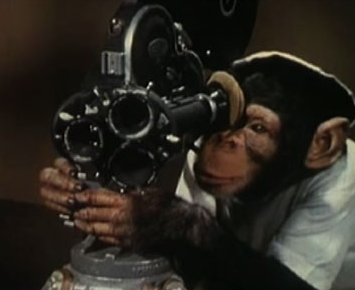Modern terminology
According to the Oxford English Dictionary, the word "monkey" may originate in a German version of the Reynard the Fox fable, published circa 1580. In this version of the fable, a character named Moneke is the son of Martin the Ape. In English, no very clear distinction was originally made between "ape" and "monkey"; thus the 1910 Encyclop?dia Britannica entry for "ape" notes that it is either a synonym for "monkey" or is used to mean a tailless humanlike primate. Such ambiguities persist. Colloquially, the terms "monkeys" and "apes" may still be used interchangeably. Due to its size (up to 1 m/3 ft) the mandrill is often thought to be an ape, but it is actually an Old World monkey. Also, a few monkey species have the word "ape" in their common name, such as the Barbary ape. Later in the first half of the 20th century, the idea developed that there were trends in primate evolution and that the living members of the order could be arranged in a series, leading through "monkeys" and "apes" to humans. Monkeys thus constituted a "grade" on the path to humans and were distinguished from "apes". Scientific classifications are now more often based on monophyletic groups, that is groups consisting of all the descendants of a common ancestor. The New World monkeys and the Old World monkeys are each monophyletic groups, but their combination is not, since it excludes hominoids (apes and humans). Thus the term "monkey" no longer refers to a recognized scientific taxon. The smallest accepted taxon which contains all the monkeys is the infraorder Simiiformes, or simians. However this also contains the hominoids (apes and humans), so that monkeys

re, in terms of currently recognized taxa, non-hominoid simians. A group of monkeys may be referred to as a mission or a tribe. The Oxford English Dictionary (OED), published by the Oxford University Press, is the self-styled premier dictionary of the English language. Work began on the dictionary in 1857:103–4,112 but it was not until 1884 that it started to be published in unbound fascicles as work continued on the project under the name A New English Dictionary on Historical Principles; Founded Mainly on the Materials Collected by The Philological Society.:169 In 1895, the title The Oxford English Dictionary (OED) was first used unofficially on the covers of the series and in 1928 the full dictionary was republished in ten bound volumes. In 1933, it fully replaced the name in all occurrences to The Oxford English Dictionary (OED) in its reprinting as twelve volumes with a one volume supplement and more supplements came over the years until in 1989 when the second edition was published in twenty volumes. As of 24 March 2011, the editors had completed the third edition from M to Ryvita. With descriptions for approximately 600,000 words, the Oxford English Dictionary is the world's most comprehensive single-language print dictionary according to the Guinness Book of World Records.[citation needed] The first electronic version of the dictionary was made available in 1988. The online version has been available since 2000, and as of August 2010 was receiving two million hits per month from paying subscribers. The chief executive of Oxford University Press, Nigel Portwood, feels it unlikely that the third edition will ever be printed